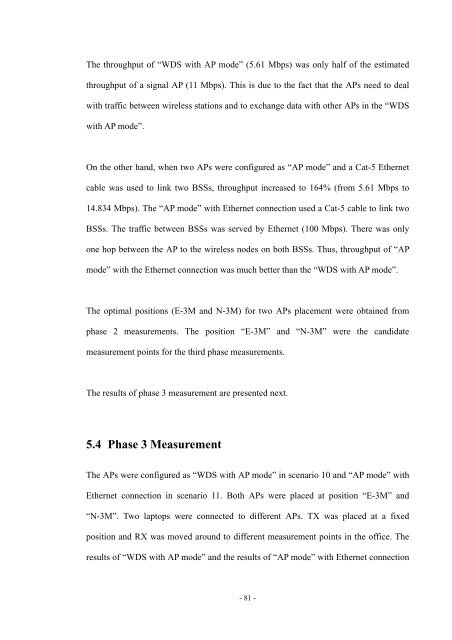An Investigation of the Impact of Signal Strength on Wi-Fi Link ...
An Investigation of the Impact of Signal Strength on Wi-Fi Link ...
An Investigation of the Impact of Signal Strength on Wi-Fi Link ...
Create successful ePaper yourself
Turn your PDF publications into a flip-book with our unique Google optimized e-Paper software.
The throughput <str<strong>on</strong>g>of</str<strong>on</strong>g> “WDS with AP mode” (5.61 Mbps) was <strong>on</strong>ly half <str<strong>on</strong>g>of</str<strong>on</strong>g> <str<strong>on</strong>g>the</str<strong>on</strong>g> estimated<br />
throughput <str<strong>on</strong>g>of</str<strong>on</strong>g> a signal AP (11 Mbps). This is due to <str<strong>on</strong>g>the</str<strong>on</strong>g> fact that <str<strong>on</strong>g>the</str<strong>on</strong>g> APs need to deal<br />
with traffic between wireless stati<strong>on</strong>s and to exchange data with o<str<strong>on</strong>g>the</str<strong>on</strong>g>r APs in <str<strong>on</strong>g>the</str<strong>on</strong>g> “WDS<br />
with AP mode”.<br />
On <str<strong>on</strong>g>the</str<strong>on</strong>g> o<str<strong>on</strong>g>the</str<strong>on</strong>g>r hand, when two APs were c<strong>on</strong>figured as “AP mode” and a Cat-5 E<str<strong>on</strong>g>the</str<strong>on</strong>g>rnet<br />
cable was used to link two BSSs, throughput increased to 164% (from 5.61 Mbps to<br />
14.834 Mbps). The “AP mode” with E<str<strong>on</strong>g>the</str<strong>on</strong>g>rnet c<strong>on</strong>necti<strong>on</strong> used a Cat-5 cable to link two<br />
BSSs. The traffic between BSSs was served by E<str<strong>on</strong>g>the</str<strong>on</strong>g>rnet (100 Mbps). There was <strong>on</strong>ly<br />
<strong>on</strong>e hop between <str<strong>on</strong>g>the</str<strong>on</strong>g> AP to <str<strong>on</strong>g>the</str<strong>on</strong>g> wireless nodes <strong>on</strong> both BSSs. Thus, throughput <str<strong>on</strong>g>of</str<strong>on</strong>g> “AP<br />
mode” with <str<strong>on</strong>g>the</str<strong>on</strong>g> E<str<strong>on</strong>g>the</str<strong>on</strong>g>rnet c<strong>on</strong>necti<strong>on</strong> was much better than <str<strong>on</strong>g>the</str<strong>on</strong>g> “WDS with AP mode”.<br />
The optimal positi<strong>on</strong>s (E-3M and N-3M) for two APs placement were obtained from<br />
phase 2 measurements. The positi<strong>on</strong> “E-3M” and “N-3M” were <str<strong>on</strong>g>the</str<strong>on</strong>g> candidate<br />
measurement points for <str<strong>on</strong>g>the</str<strong>on</strong>g> third phase measurements.<br />
The results <str<strong>on</strong>g>of</str<strong>on</strong>g> phase 3 measurement are presented next.<br />
5.4 Phase 3 Measurement<br />
The APs were c<strong>on</strong>figured as “WDS with AP mode” in scenario 10 and “AP mode” with<br />
E<str<strong>on</strong>g>the</str<strong>on</strong>g>rnet c<strong>on</strong>necti<strong>on</strong> in scenario 11. Both APs were placed at positi<strong>on</strong> “E-3M” and<br />
“N-3M”. Two laptops were c<strong>on</strong>nected to different APs. TX was placed at a fixed<br />
positi<strong>on</strong> and RX was moved around to different measurement points in <str<strong>on</strong>g>the</str<strong>on</strong>g> <str<strong>on</strong>g>of</str<strong>on</strong>g>fice. The<br />
results <str<strong>on</strong>g>of</str<strong>on</strong>g> “WDS with AP mode” and <str<strong>on</strong>g>the</str<strong>on</strong>g> results <str<strong>on</strong>g>of</str<strong>on</strong>g> “AP mode” with E<str<strong>on</strong>g>the</str<strong>on</strong>g>rnet c<strong>on</strong>necti<strong>on</strong><br />
- 81 -
















